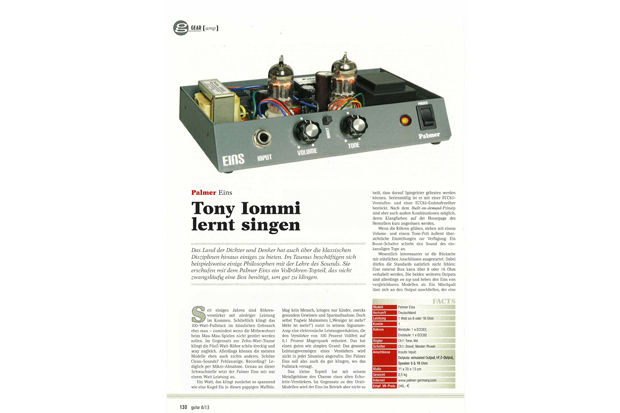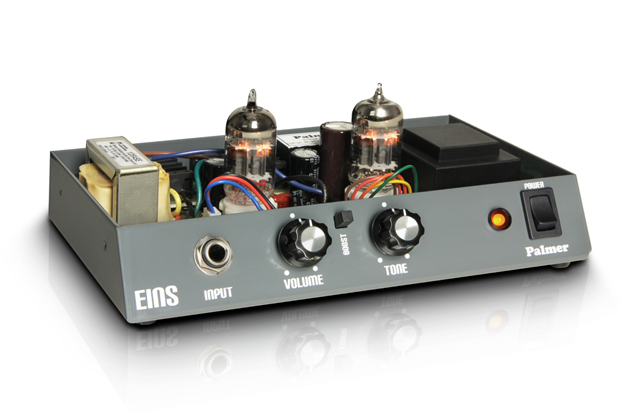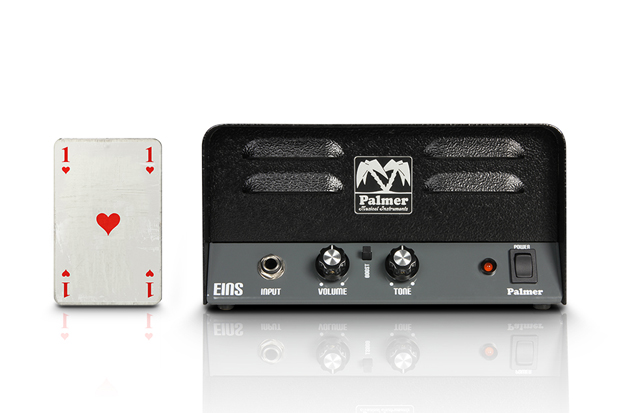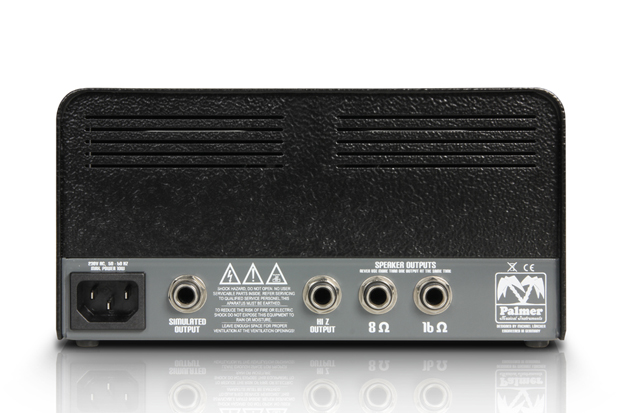Palmer EINS – Tony Iommi learns to sing – Test Report by Guitar Magazine
The land of poets and philosophers also has a lot to offer above and beyond the classic disciplines. In the Taunus Highlands, for example, some philosophers are devoting themselves to the science of sound. With the Palmer EINS, they created an all-tube head that doesn’t necessarily need a cabinet in order to sound good.

Low-powered tube amplifiers have been gaining ground for a few years now. After all, a 100-watt full stack sounds pretty lukewarm at home – at least, if you want to avoid disturbing your neighbours while they are playing mau mau. Unlike a ten-watt transistor amp, the five-watt tube amplifier sounds dirty and sexy at the same time. However, most models just can’t do anything else. Pretty clean sounds? No chance. Recording? Only if you mic it. This is precisely the weak point that the one-watt Palmer EINS addresses.

Fig. 1: Palmer EINS
One watt: at first that sounds about as exciting as a scoop of ice cream in one of those cardboard-like cones. No one likes them; they are strictly kid stuff intended to ease consciences and save money. But even Yngwie Malmsteen (“Less is more? More is more!”) has a signature amp that incorporates an electronic power reduction feature which reduces the amplifier from 100 percent cream to 0.1 percent skimmed curds. There is a good and simple reason why: the entire output of an amplifier isn’t used in every situation. So the Palmer EINS is intended to also sound good in situations in which a full stack doesn’t. With its metal housing, the little head exudes the charms of an old Echolette amplifier. Unlike the ancient models, however, the EINS doesn’t get hot enough to fry an egg on it. It comes with an ECC83 preamp tube and an ECC82 power stage tube as standard. The settings available once the tubes are warm are extremely straightforward, consisting of a volume knob and a tone knob. A boost switch gives the sound of the single-channel head an extra push.
The host of useful connectors on the rear panel is much more interesting. Of course all of the standard ones are there: there are 8- and 16-ohm outputs for an external speaker cabinet. The two additional outputs, however, are on top and set the EINS apart from comparable models. The simulated speaker output can be connected to a mixing board. The hi-Z output connects the Palmer to the instrument input of a big amp. The possibilities entailed in this are easy to explain practically.
First we roll in the 4×12″ cabinet and put it under the EINS. In doing so, it becomes clear just how loud one watt can be. Up to the 2-o’clock position, the sound is clean, but already much richer than a dialled down tube amplifier with considerably more power. Starting at about 2 o’clock, the EINS crunches out a yummy brown sound. The tone control has a pleasant range that sounds neither muddy nor spiky at extreme settings. The boost knob gives the sound a powerful extra push. The volume control turns into a gain control and creates a snotty distortion that, however, has all of the punch that one watt can deliver. All the same, the sound coming out of the cabinet is really ballsy. It can be harnessed for crunchy riffs and smacking power chords. The tone control gives the sound the definition that it loses with increasing volume. This is how not only Carlos Santana sings, but Toni Iommi as well. In conjunction with a mixer or audio interface, the EINS is great for playing through headphones or recording. Even big stars use little tube amps in the studio, since they react more dynamically than the full stacks that they use onstage. The simulated speaker output creates a sound that is easy to record with a sequencer. The result is noise-free and just as warm as the sound from a cabinet. Nevertheless, the dynamics are preserved and each tone is multifaceted. Recording should be this simple! Fig. 2: The ace of hearts when it comes to mini amps: the Palmer EINS
Fig. 2: The ace of hearts when it comes to mini amps: the Palmer EINS
Finally, we connect the EINS to a big amp by putting it in the normal signal path leading to the instrument input. Here, too, there are multiple possibilities. For one thing, the amplifier’s tube sound does a lot for the ten-watt transistor amp. It makes the clean sound much more direct, which results in great responsiveness to the player’s touch. With the boost switch, it creates a sound reminiscent of a saw tooth fuzz. Purple haze all in my room! Depending on the size of the speaker, the Eins makes a transistor amp sound a lot better. On the other hand, the amplifier also makes an outstanding booster in conjunction with other tubes. The Spartan controls remind one of an effects pedal anyway, and it is possible to add or reduce the sound of the EINS in exactly the same manner. Here the amp reveals its true potential. Suddenly, it no longer does just classic rock, but can also get pretty heavy. It gives the amplifier signal a big boost and gives the solo sound definition, warmth, and punch. In this, the EINS demonstrates that it can be a big help not only to blues and rock guitarists, but metal heads as well.
Lasting impressions
People know that Palmer makes good DI boxes and speaker simulators. The EINS combines these useful helpers in one amplifier. It may have “just” one watt of power, but it rocks a lot harder than comparable models. The two tubes create a clean sound worthy of the name and a snotty distortion sound which, thanks to ease of operation, always sound warm and never scratchy.
The good tone, however, is only the solid foundation for the additional features. It makes small transistor amps sound much better thanks to its rich overdrive and gives big amps a real boost. The simulated speaker output is the whipped cream on top that makes a treat out of even the most cardboard-like ice cream cone. This is ice cream for grownups!

Click here for more information about this product:
http://www.palmer-germany.com/mi/en/EINS-Full-Tube-Guitar-Amplifier-1W-PEINS.htm
Source: guitar Magazin, Germany, May 2013
Author: Jens Prüwer
Leave a Comment
You must be logged in to post a comment.












